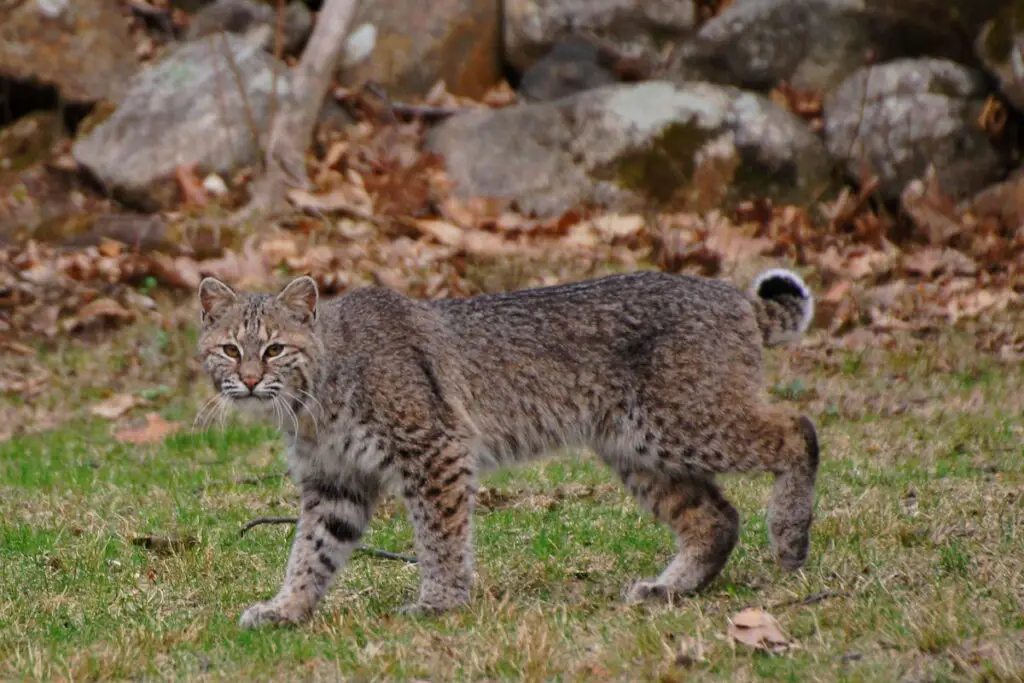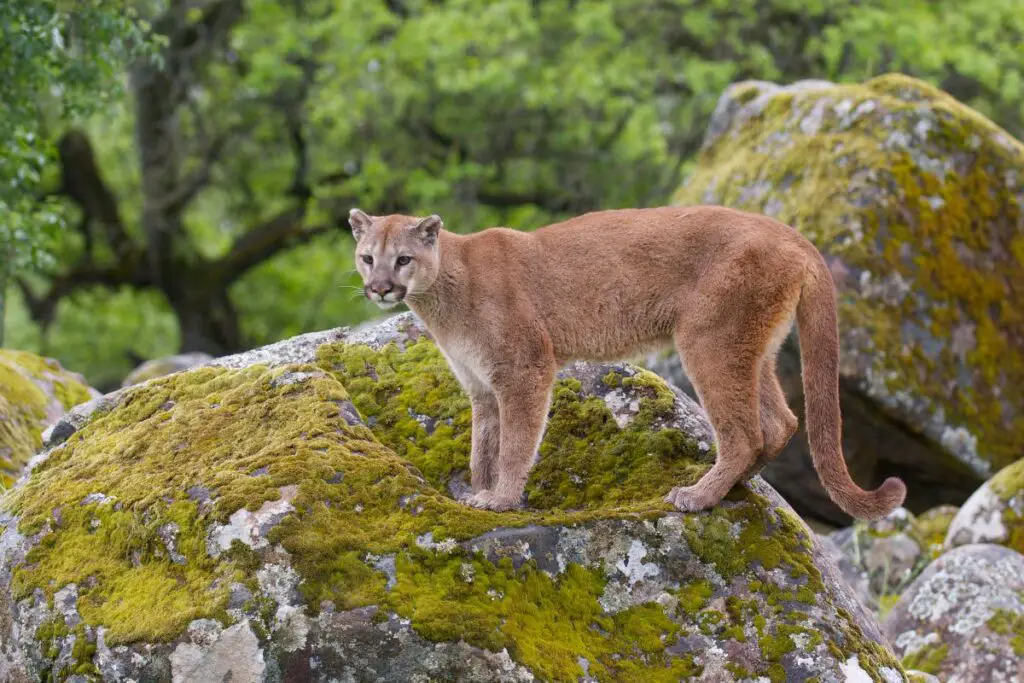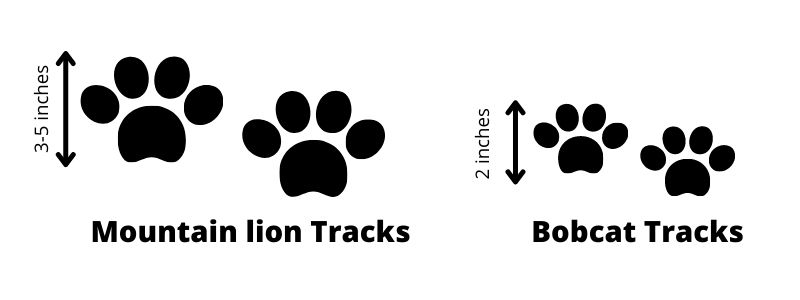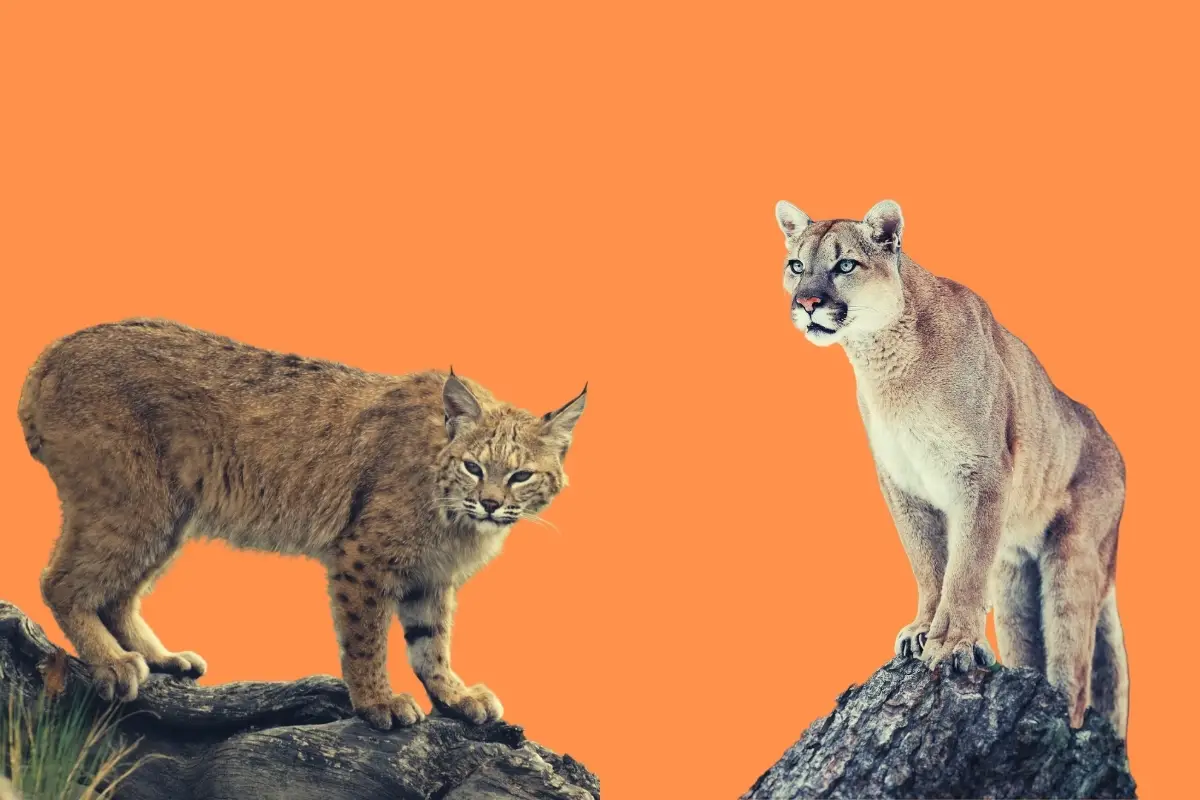There are multiple types of wild cats, however, not all of them are the same size or have the same looks. We’re going to go over the differences between a bobcat (Lynx rufus) and a mountain lion (Puma concolor.)
Mountain Lion Vs Bobcat
Mountain lions are larger, coming in at 7-8 feet, with bobcats being 3 to 3.5 feet in length. A bobcat weighs 20-30 lbs, while a mountain lion weighs up to 150 pounds. Bobcats are white, brown, and rust-colored, while mountain lions are white, tan, and shades of brown.
Both of these cats share a lot of the same traits. The bobcat is probably the closest relative to the mountain lion. They make similar noises and live in some of the same regions.
They have a similar diet, although bobcats tend to eat small prey, such as rodents and rabbits, while mountain lions will eat larger animals like deer, elk, and sheep. These cats are known to be dangerous, however, the mountain lion is most likely a bigger threat to a human than a bobcat.
Bobcat Vs Mountain Lion Face
A bobcat’s face is very different from a mountain lion’s face. A bobcat has a ruff of fur on each side of its cheeks. A mountain lion’s cheeks have very short smooth-looking fur, almost the complete opposite of a bobcat’s.
The bobcat has thick fur around its neck and much thicker fur in general. The mountain lion has an even amount of short fur that covers its face and neck. The bobcat’s face may have stripes or banding, whereas the mountain lion’s face is a mix of white, tan, and tawny colors.

Bobcat Vs Mountain Ears
Because bobcats are lynxes, they have tufts of fur on the tips of their ears. This makes them very easily distinguishable from mountain lions. The tufts can be thick and long on some bobcats, and shorter on others.
The mountain lion has no tufts on the ears, just smooth edges. Both of these wild cats have Henry’s pockets, which are little pockets inside of the ear, that pick up high-pitched sounds. This is great for these cats because they feed on some of the same small mammals such as rodents, and rabbits.

Is a Bobcat the Same as a Mountain Lion?
Bobcats and mountain lions are two separate species and different genera, however, they share the same family. While it is thought that bobcats are probably the most “similar relative” to mountain lions, they are very different. wild cats sometimes get lumped together, when in reality they have a lot of genetic differences. Source.
The most notable difference between these two is their size. Mountain lions tower over bobcats. Many other creatures get mistaken for mountain lions because the mountain lion is very rarely ever seen. People have mistaken deers, dogs, and even bobcats for mountain lions when viewing them from a distance.
Mountain lions are also known as pumas, cougars, catamount, and panthers. There are over 40 names for mountain lions.
Also, check out Mountain Lion vs Lion!
Scientific Classifications
Bobcats
| Bobcat | |
| Kingdom | Animalia |
| Phylum | Chordata |
| Class | Mammalia |
| Order | Carnivora |
| Family | Felidae |
| Scientific Name | Lynx Rufus |
Mountain Lions
| Mountain Lion | |
| Kingdom | Animalia |
| Phylum | Chordata |
| Class | Mammalia |
| Order | Carnivora |
| Family | Felidae |
| Scientific Name | Puma Concolor |
Which is More Dangerous a Bobcat or a Mountain Lion
Both of these wild cats are wild animals and should be considered dangerous. They are carnivores that eat mammals such as deer and rabbits, so house pets and even humans should keep their distance from these wild cats.
If a bobcat and mountain lion fight over territory, it is more likely that the mountain lion would win that fight. Both of these cats can be vicious, however, with the size of a mountain lion, the bobcat probably wouldn’t stand a chance.
If you think you have a bobcat or mountain lion in your area, make sure to steer clear of them, and if you do choose to view them, make sure you keep your distance and stay quiet. The last thing you want to do is spook a wild cat that may see you as a meal or a threat.
See our article for Are Bobcats Dangerous

Bobcat vs Mountain Lion Sounds
Both of these cats make a variety of cat-like noises. They hiss, they growl, they screech. Long ago I lived in a cabin and thought I was hearing the sound of a baby crying, come to find out that it was a mountain lion, after seeing it on a nearby trail cam.
Mountain lions do not venture into human territory as often as a bobcat may. Bobcats have ventured further into urban areas because of their diverse habitats and ability to adapt. While mountain lions prefer to stay away from human activity.
See our article for What Does a Bobcat Sound Like
What is the Difference Between a Bobcat and a Mountain Lion
There are some pretty big differences between these two wild cats so let’s take a look at what sets them apart from each other.
| Bobcats Differences | Mountain Lion Differences |
| Bobcats are much smaller than mountain lions. | Mountain lions are three to four times the size of a bobcat. |
| The bobcat eats smaller mammals such as rodents, rabbits, voles, birds, and reptiles. | The mountain lion has much bigger prey, eating different types of deer and goats. |
| The bobcat’s tail is very short, around 5 inches long or shorter, this is why they are called bobcats. | A mountain lion’s tail can be as long as 2-3 feet. They use their tails for balance. |
| Bobcats’ fur usually has spots and stripes that make them easy to tell apart from mountain lions. | Mountain lions are cinnamon and golden in color, however, baby mountain lions sometimes have spots. |
Bobcat vs Mountain Lion Tracks
The footprint pattern of these wildcats is similar in shape but different in overall size. The mountain lion has the largest tracks of any feline in the United States. They have the same amount of digits (4 round digits) and the same shape of footpad also known as a carpal pad.
The bobcat’s footprints are around 2 inches long and the same wide, while a mountain lion’s footprint is around 3-5 five inches long and the same wide. Bobcat footprints sometimes get mistaken for foxes, however, the bobcat’s footprints do not have claw indentions because their claws are retractable. Source.

Bobcat and Mountain Lion Comparison Chart
| Bobcat Comparison | Mountain Lion Comparison |
| A bobcat is considered to be a “wild cat” of North America. | Although the mountain lion is larger, it is also considered a wild cat and not a big cat, because it does not roar. |
| Bobcats hunt small mammals, such as rodents, rabbits, and small deer. | Mountain lions also hunt some of the same animals, such as rabbits, small deer, and other mammals. |
| Bobcats have retractable claws, which help them grip the terrain, and move safely through wooded areas. | Mountain lions also have retractable claws, and their footprints usually will not have claw marks. |
| Bobcats have a stable population in North America and are not considered endangered. | Mountain lions also have a stable population and are not on the endangered species list. |
Can Bobcats Breed With Mountain Lions?
These two wild cats most likely cannot breed. They are a different genus and the size difference would also make it mostly impossible. On top of that, the two would be enemies because they would fight over territory, so there would be no special romance there!
However, still, people have claimed to see animals that resemble some type of mountain lion bobcat hybrid. Scientifically, the two animals would need a matching number of chromosome sets, which they both have.
Bobcat vs Mountain Lion Poop
One of the best ways to track an animal or to find out what types of animals live in your area is to analyze their scat or poop. The scat of an animal can tell you what they are eating, and help identify them.
Bobcat poop is segmented and tubular. It tends to be 2.5 to 5 inches long and a half-inch to inch thick. Mountain lions, on the other hand, have poops that are 6-15 inches long! And an inch or thicker. They may be solid or segmented.
Bobcat vs Mountain Lion Size
We mentioned the size difference between bobcats and mountain lions. So let’s look at their heights, lengths, and weights. Bobcats are around 20 inches to 50 inches in length and around 12 to 24 inches shoulder height.
Mountain lions are much larger. An Adult male mountain lion can be up to 8 feet long! This is from the nose to the tail. They are around 2-3 feet tall in shoulder length. Source.

Will a Mountain Lion Eat a Bobcat
These wild cats are natural enemies, and the mountain lion is a predator of the bobcat. Chances are the mountain lion would choose easier prey, but if food sources were scarce, it could resort to killing and eating a bobcat. It certainly has the size and occupies some of the same territories.
These two would most likely clash over territory, not because they are starving, in this case, it would be a fight to the death and the bobcat would probably not win. The mountain lion eats 30-40 pounds of meat per day, so it would most likely not waste the kill and would end up eating the bobcat.
To learn more about mountain lions check out Are Mountain Lions Dangerous?
Bobcat Vs Mountain Lion Vs Cougar
Bobcats are a species of wild cat that lives in North America. Mountain lions and cougars are the same animal. Some people call cougars mountain lions, while others know them by many other names.
Bobcats are different from mountain lions and have different genera. Because a mountain lion is a cougar, they are in the same genus. However, bobcats and mountain lions (cougars) have the same scientific family.
Related Questions
Do bobcats and mountain lions get along?
Bobcats and mountain lions are considered natural enemies because they share overlapping territories. Both of these wild cats are territorial and will fight over food sources.
What animal can beat a mountain lion?
Mountain lions do not have very many predators that are above them. Humans and bears are probably the biggest threat to mountain lions. Humans hunt them, and bears kill or eat them.
- Hero Farm Dog Survives Epic Battle with Coyote Pack - December 9, 2024
- The 10-Minute Bedtime Routine That Changed My Dog’s Sleep Forever - November 29, 2024
- Creating a Safe Space for Nervous Pets: Your Guide to Pet-Friendly Havens - November 25, 2024

